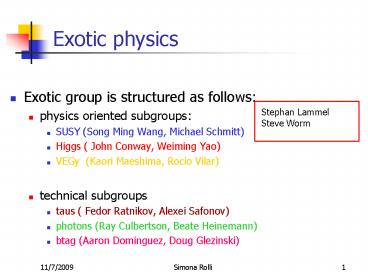Exotic physics PowerPoint PPT Presentation
1 / 17
Title: Exotic physics
1
Exotic physics
- Exotic group is structured as follows
- physics oriented subgroups
- SUSY (Song Ming Wang, Michael Schmitt)
- Higgs ( John Conway, Weiming Yao)
- VEGy (Kaori Maeshima, Rocio Vilar)
- technical subgroups
- taus ( Fedor Ratnikov, Alexei Safonov)
- photons (Ray Culbertson, Beate Heinemann)
- btag (Aaron Dominguez, Doug Glezinski)
Stephan Lammel Steve Worm
2
Analysis Strategies
- Two different approaches strongly pushed on both
sides - A) Traditional model driven analyses
- pick a favorite theoretical model pick a process,
choose the best signature(s) optimize selection
acceptances based on signal MC - calculate the expected background
- evaluate the limit or discovery your signal
- B) Signature based approach
- pick a specific signature ( i.e. diphotonX)
- define your sample in terms of known processes
- publish estimates of acceptances cross section
information useful for theorists - see an excess? Inconsistency with SM? Test one
or more models later
Useful at the beginning
? might become soon outdated!
? best optimization!
? not best optimization but...? open to a whole
lot of models! An unbiased study is fundamental
for data understanding
3
Current status
- Several model based analysis ongoing
- Searches for mass bumps in DY spectrum
- Z and Randall-Sundrum graviton
- Searches for mass bumps in the dijet spectrum
- Searches for CHAMPS
- New limits on Leptoquarks in the MET jets
channel and dielectrons jets channel - Signature based approach
- physics involving photons
All at the stage of proto-analysis confirmation/up
dates of run I results
4
Current status ( contd)
- Same concerns/issues as the Top group
- No analysis involving b-tagging
- Calorimeter understanding and simulation still a
problem - very cumbersome data processing and access
- general software problems
- some datasets still being validated
- SUSY dileptons
- MET
5
Where do the Italians fit?
- Higgs group
- Z -gt bb
- Higgs multijets (using) SVT trigger
- MSSM Higgs (taus )
- For SM Higgs (WH/ZH, lvbb and vvbb channels)
there is the need for - jet corrections,
- dijet mass reconstruction
- b tagging
- background modeling
Covered in other subgroups
6
Higgs review commitee
- A committee has recently been formed and charged
with making a re-evaluation of CDF's Standard
Model Higgs search potential. This is motivated
by a request made by the Director of DOE's Office
of Science. The work of this committee will be
closely coordinated with a parallel committee at
D0 and the results will be combined to produce a
Tevatron statement of the Higgs discovery
potential in Run 2. In contrast to the
projections done previously by a SUSY-Higgs
Working Group, this report is expected to be
blessed by the CDF and D0 Collaborations.
Good opportunity for contributions
Timescale June 2003
7
Higgs searches at TeV II
- Needed new tools
- Jet energy resolution
- supplementing calorimetry information with
tracking and SMX should give a 30 improvements - The Mbb resolution can be improved up to 50
- Z?bb studies
- b-tagging techniques
- SVT allow for a sample enriched in HF
- offline b-tag could benefit from
- 3D Si-tracking to reduce mistags
- loose tagging techniques still viable ( SLT, JPB)
8
The quest for Higgs at run II
- Higgs production and decay
- ggH dominates over all mass ranges, but huge QCD
backgrounds. - MHlt130 GeV/c2 Low mass Higgs.
- H?bb with Associated production mode is the most
promising. The double b-tagging together with the
signature of the additional boson helps to
discriminate from the background.
- Trigger strategies
- SVT to select a sample enriched in heavy flavors
- qqbb, MET bb
With METgt15 the Turn-on plateau is reach for
METoffline gt30 GeV For cuts METofflinegt40 an
efficiency increase of 1.4 can be reached in
respect to run I.
9
Run II extrapolations
MET bb In respect to run I, factor 1.4
(turn-on) x 1.3. (improved geometrical acceptance)
Multijets in respect to runI factor 3 ( double
b-tag efficiency)x1.3.
- Assuming the same Signal to Background ratio as
in RUN-I, the cross section limit at 95
confidence level has been scaled as - EffRI / EffRII x ?(L R-I / LR-II)
10
Run II SM Higgs sensitivity
To be revised or confirmed?
11
SUSY
Heavy flavor jets MET taus
12
SUSY squarks and gluinos
13
Stop and sbottom
14
Stop in SS dileptons
15
Stop and taus
16
Some remarks on SUSY searches
- With direct searches is possible to probe SUSY
existence in a good mass range - on the other hand direct searches are limited by
the final integrated luminosity and ?s - Also, we need to constrain somehow SUSY
- very limited reach is left in MSUGRA ( LEP
exhausted almost all) - at FNAL theorists are working on new benchmarks
scenario - possible connections with Italian theorists?
- Constraints are in general model-dependent..
17
Conclusions
- The exotic group is starting producing results
from run II data - most of them are confirmations/updates of run I
results - limited by statistics and LEP final results
- Lots of work needs to be done in terms of
understanding the detector before claiming new
physics - MET for all
- common topics with high pt top/ew group

